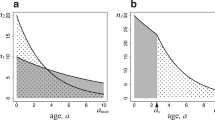Summary
-
1.
Two extreme possibilities in the evolution of temporal castes can be envisaged. First, workers can undergo changes in responsiveness to various kinds of stimuli in a strongly discordant manner as they grow older, so that each task is addressed by a distinctly different frequency distribution of workers belonging to different age groups. Because these age-frequency distributions change almost gradually from one task to another in covering many such tasks, the resulting temporal caste system is referred to as continuous. At the opposite extreme, the aging worker can undergo changes in responsiveness to different stimuli in a highly concordant manner, so that all of the tasks are attended by one or relatively few frequency distributions of workers belonging to different age groups. The resulting temporal caste system is referred to as discrete, and the evolutionary process leading to it is called behavioral discretization (Fig. 1).
-
2.
The temporal system of the minor worker caste of Pheidole dentata proves to be much closer to the discrete state, although it is not extreme in form (Figs. 3, 4). On the basis of ethograms constructed of stressed and unstressed colonies in which the approximate ages of the minor workers were known, it is possible to recognize five discrete female castes: the queen, a single temporal subcaste of the major worker, and three temporal subcastes of the minor worker. These are the elements which can now be employed in ergonomic analyses of the species' caste system.
Similar content being viewed by others
References
Cammaerts-Tricot, M.-C.: Production and perception of attractive pheromones by differently aged workers of Myrmica rubra (Hymenoptera: Formicidae). Insectes Soc. 21, 235–247 (1974)
Cammaerts-Tricot, M-C.: Ontogenesis of the defence reactions in the workers of Myrmica rubra L. (Hymenoptera: Formicidae). Anim. Behav. 23, 124–130 (1975)
Dobrzańska, J.: Studies on the division of labour in ants genus Formica. Acta Biol. Exper. 19, 57–81 (1959)
Ehrhardt, S.: Über Arbeitsteilung bei Myrmica- und Messor-Arten. Z. Morphol. Ökol. Tiere 20, 755–812 (1931)
Fagen, R.S., Goldman, R.: Behavioural catalogue analysis methods. Anim. Behav., in press (1976)
Michener, C.D.: The social behavior of the bees: a comparative study Cambridge, Mass.: Belknap Press of Harvard Univ. Press 1974
Oster, G.: Modelling social insect populations, I: ergonomics of foraging and population growth in bumblebees. Am. Naturalist, in press (1976)
Otto, D.: Über die Arbeitsteilung im Staate von Formica rufa rufopratensis minor Gössw. und ihre verhaltensphysiologischen Grundlagen, ein Beitrag zur Biologie der Roten Waldameisen. Wiss. Abh. Dt. Akad. Landw.-Wiss. Berl. 30, 1–169 (1958)
Schmidt, G. (ed.): Sozialparasitismus bei Insekten. Stuttgart: Wissenschaftliche Verlagsges. mbH 1974
Trivers, R.L., Hare, H.: Haplodiploidy and the evolution of the social insects. Science 191, 249–263 (1976)
Weir, J.S.: Polyethism in workers of the ant Myrmica. Insectes Soc. 5, 97–128; 315–339 (1958)
Wilson, E.O.: The ergonomics of caste in the social insects. Am. Naturalist 102, 41–66 (1968)
Wilson, E.O.: The insect societies. Cambridge, Mass.: Belknap Press of Harvard Univ. Press 1971
Wilson, E.O.: Enemy specification in the alarm-recruitment system of an ant. Science 190, 798–800 (1975)
Wilson, E.O.: The organization of colony defense in the ant Pheidole dentata Mayr. Behav. Ecol. Sociobiol. 1, 63–81 (1976a)
Wilson, E.O.: A social ethogram of the Neotropical arboreal ant Zacryptocerus varians. Anim. Behav., in press (1976b)
Author information
Authors and Affiliations
Rights and permissions
About this article
Cite this article
Wilson, E.O. Behavioral discretization and the number of castes in an ant species. Behav Ecol Sociobiol 1, 141–154 (1976). https://doi.org/10.1007/BF00299195
Received:
Issue Date:
DOI: https://doi.org/10.1007/BF00299195




